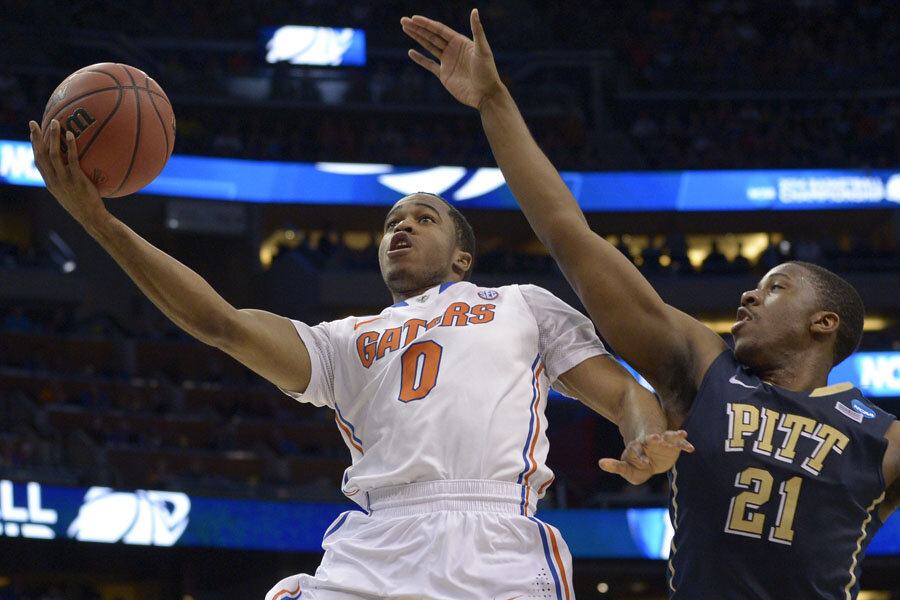NCAA Sweet 16: Power conferences step up in 'Big Dance'
Loading...
After three rounds of the 2014 NCAA men's basketball tournament, there are three power conferences who are crowing as we move toward the regional semifinals - aka the Sweet 16 - beginning Thursday evening.
The Southeastern, Big Ten, and Pacific 12 conferences each have three schools remaining in "March Madness."
For the SEC, Florida and Kentucky, the two teams that played for the league's postseason tournament title, are still in it. And quietly flying under the radar is Tennessee, who has had to win three games to get to this point. The Volunteers beat Iowa in overtime, then overwhelmed both No. 6 seed Massachusetts and Cinderella upstart Mercer.
The Big Ten is a tough, rugged league. So it should be no surprise that three conference schools continue to hang around. Michigan, Wisconsin, and Michigan State have methodically moved into the regional semifinal round.
Eleven-time national champion UCLA from the Pac-12 remains in the mix, along with the West's top seed Arizona and the South's 10th seed Stanford which knocked off second seed Kansas.
Both the Big 12 and American Athletic conferences have two teams left in the tournament. Iowa State has enjoyed a renaissance under former Cyclone star and head coach Fred Hoiberg. Baylor has competed at the highest levels of the conference during the regular season. The Bears have reached the Sweet 16 for the third time in four years.
Defending national champion Louisville won the inaugural American Athletic Conference postseason tournament. Connecticut, under Shabazz Napier, needed overtime to beat St. Joseph's and dispatched old Big East foe Villanova.
Interestingly enough, the quartet of fourth-seeded teams - Michigan St., Louisville, UCLA, and San Diego State - remain in the hunt for a national championship.
Three of the top seeds - Virginia, Florida, and Arizona - are still in play, as are second seeds Wisconsin and Michigan.
And, of course, we can't leave out Dayton, the 11th seed in the South. The Flyers have knocked off both Ohio State and Syracuse to reach the Sweet 16 for the first time in 30 years.
When the NCAA selects the 68 teams for the tournament, a sizable factor for determining those schools is the Ratings Percentage Index, or RPI. It's a formula based on three elements, according to rpiratings.com: the individual team's Division 1 winning percentage, the team's opponents' winning percentage, and the team's opponents' opponents' winning percentage. In essence, the RPI measures how well individual schools create a competitive non-conference schedule and how well the schools perform on the court.
This formula also extends to the conferences themselves and based on those numbers, the NCAA tournament selection committee has done well. Prior to the tournament's start, the Big 12 was No. 1 in conference RPI, Big Ten No. 2, Pac-12 No. 3, and SEC No. 7 out of 32 conferences, according to CBSSports.com.
As for individual teams left in the "Big Dance," from a statistical standpoint, Nate Silver's Fivethirtyeight blog has Florida winning the national championship. The Gators, the NCAA tournament's overall No. 1 seed, are expected to reach the "Final Four" and defeat either Louisville or Arizona in the title game.
Looking to future NCAA tournaments, there is a tool that could help other Division 1 teams compete against the power conferences. New in-arena technology is available to help break down team performance, as reported in the New York Times.
The system, called SportVU, was developed by the sports analysis company Stats L.L.C. with technology whose roots are in the Israeli military. SportVU’s cameras, six in each arena, record data points for everything that moves on the floor — the players, the referees and even the ball — every thirtieth of a second.
The system tracks every dribble, pass, screen, shot, rebound and movement. It can reveal how often the ball enters the lane and what happens when it gets there. It can tell coaches who is taking contested shots and who is taking open ones — and how often they make them.
All it takes is money, which the power conferences have and everyone else is chasing, along with recruits.








